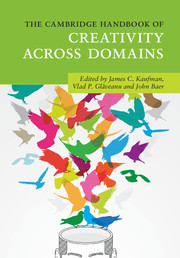Book contents
- The Cambridge Handbook of Creativity Across Domains
- The Cambridge Handbook of Creativity Across Domains
- Copyright page
- Dedication
- Contents
- Figures
- Tables
- Contributors
- Acknowledgments
- Part I Creativity and Domain
- Part II Creativity in the Traditional Arts
- Part III Creativity in the Sciences
- Part IV Creativity in Business
- Part V Newer Domains for Creativity Research
- Part VI Creativity in Everyday Life
- 29 Creativity in the Domain of Emotions
- 30 Creativity in Teaching
- 31 Culture and Creativity
- 32 The Benefits of Creativity in Therapy
- 33 Creativity in the Domain of Play
- 34 Creativity in Craft
- Part VII Conclusion
- Index
- References
34 - Creativity in Craft
from Part VI - Creativity in Everyday Life
Published online by Cambridge University Press: 15 September 2017
- The Cambridge Handbook of Creativity Across Domains
- The Cambridge Handbook of Creativity Across Domains
- Copyright page
- Dedication
- Contents
- Figures
- Tables
- Contributors
- Acknowledgments
- Part I Creativity and Domain
- Part II Creativity in the Traditional Arts
- Part III Creativity in the Sciences
- Part IV Creativity in Business
- Part V Newer Domains for Creativity Research
- Part VI Creativity in Everyday Life
- 29 Creativity in the Domain of Emotions
- 30 Creativity in Teaching
- 31 Culture and Creativity
- 32 The Benefits of Creativity in Therapy
- 33 Creativity in the Domain of Play
- 34 Creativity in Craft
- Part VII Conclusion
- Index
- References
Summary
This chapter reviews research in the area of creativity and craft in psychology and connected disciplines. It stars by asking whether craft can be considered a domain and, in particular, if it is a creative one. Reflecting on the meaning of creativity in craftwork, it is argued both that a new definition of creativity is needed to capture aspects specific for this domain and that craft-like practices underpin creative activity in most other creative domains. Research on creative craft is presented in relation to its focus on creative actors, audiences, actions, artifacts, and affordances. Methodological issues associated with the study of craft are also reviewed and proposals made for a more comprehensive approach to craft creativity. In the end, four themes are abstracted from this domain and their relevance for the broader field of creativity studies is discussed.
- Type
- Chapter
- Information
- The Cambridge Handbook of Creativity across Domains , pp. 616 - 632Publisher: Cambridge University PressPrint publication year: 2017
References
- 8
- Cited by



